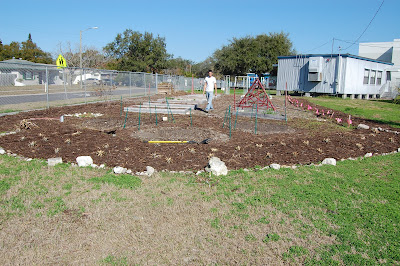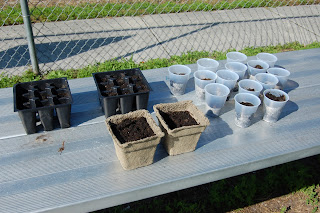 The goal of today was to teach our Lakewood Elementary children about different types of soil. We set up a hands-on activity that allowed students to touch sand, silt, and clay in tin pans. The children loved seeing their new Eckerd friends and getting into the same groups they were assigned from last week. Once we were arranged in our fun groups we played some "get to know ya" games by having the children remind us big college kids the rules of the garden and their favorite veggies! Next, the students used their five senses to discribe what each soil feels like. One little boy said " I love the beach! I know that this sand must be from St.Pete beach!." We also let the youngsters use their five senses to explore the beds as well (pictured below).
The goal of today was to teach our Lakewood Elementary children about different types of soil. We set up a hands-on activity that allowed students to touch sand, silt, and clay in tin pans. The children loved seeing their new Eckerd friends and getting into the same groups they were assigned from last week. Once we were arranged in our fun groups we played some "get to know ya" games by having the children remind us big college kids the rules of the garden and their favorite veggies! Next, the students used their five senses to discribe what each soil feels like. One little boy said " I love the beach! I know that this sand must be from St.Pete beach!." We also let the youngsters use their five senses to explore the beds as well (pictured below). After the children told me how the soil smelled, looked, and tasted ( just kidding!), they were ready to have a soil race! The race involved all of the students: three students poured water over saran wrapped cups topped with either sand, silt, or clay, while the other three observed which soil type let water through the fastest. The kids were really excited to see which type of soil would escape the cup first!
After the children told me how the soil smelled, looked, and tasted ( just kidding!), they were ready to have a soil race! The race involved all of the students: three students poured water over saran wrapped cups topped with either sand, silt, or clay, while the other three observed which soil type let water through the fastest. The kids were really excited to see which type of soil would escape the cup first!
Once the races were finished my group really wanted to taste some of the dill plant (pictured above, right). As we were heading over, Sarah H. noticed that a beet was ready to be harvested. The children were really excited to see it come out of the ground! The kids were eager to eat the beet right away, but I assured them they would enjoy it in the wellness kitchen sometime soon!
Until next time,
-Saige Liparulo


 One of the best parts about being a part of the EDIBLE garden is just that...the kids LOVE to eat things! Today we tried the Dill...which, according to the Lakewood gardners, apparently tastes nothing like pickles.... :) and kale which they seemed to enjoy more. Sarah has been cooking up some delicious Kale chips and the kids are absolutely loving them!
One of the best parts about being a part of the EDIBLE garden is just that...the kids LOVE to eat things! Today we tried the Dill...which, according to the Lakewood gardners, apparently tastes nothing like pickles.... :) and kale which they seemed to enjoy more. Sarah has been cooking up some delicious Kale chips and the kids are absolutely loving them!





 Besides the teaching, there is a lot of other things going on in the garden as well. The painting of the beds is now complete, the sedge war continues on with more mulch to cover it and hands to pull it, and weeds are now match against our volunteers. Between the IS ladies, our grad student, and our professor, the planning never stops and our volunteers really give us the ability to make it all come together and work. I am so excited to see how things progress this semester. I've been on the project since August, so this is my first time in the garden is the spring and it's all growing so fast!
Besides the teaching, there is a lot of other things going on in the garden as well. The painting of the beds is now complete, the sedge war continues on with more mulch to cover it and hands to pull it, and weeds are now match against our volunteers. Between the IS ladies, our grad student, and our professor, the planning never stops and our volunteers really give us the ability to make it all come together and work. I am so excited to see how things progress this semester. I've been on the project since August, so this is my first time in the garden is the spring and it's all growing so fast!






































